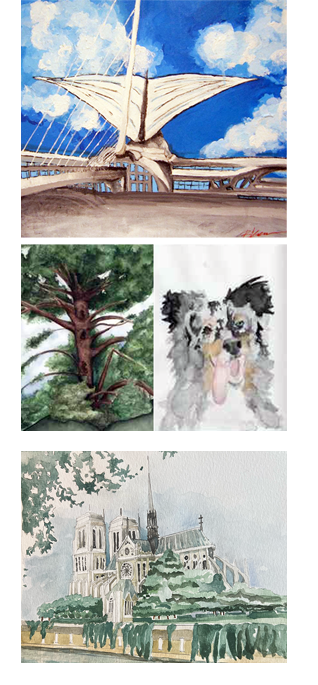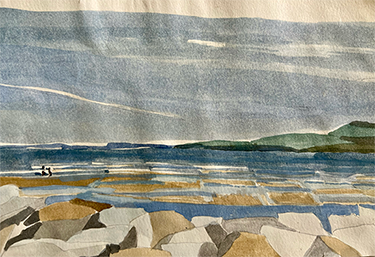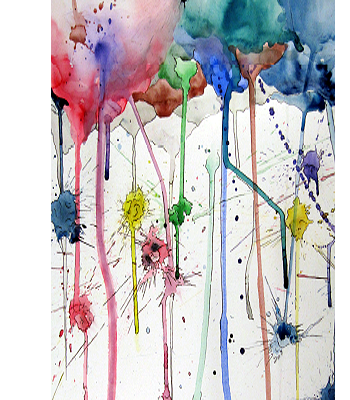
Painting is the act of putting pigment onto a surface. The surface may be stone, wood, canvas, glass, paper, or any variety of material. The paint itself is made up of pigment, or a substance that creates color in the medium. Pigments can be from plants or animals (organic pigments) or derived from salts and metallic oxides (inorganic pigments). Paints can be water-based (water color, acrylic) or oil-based (oil paints). People have been artistically painting since the earliest known civilizations. See Caves of Lascaux.
Paintings represent, document, and express the ideas and intentions of the painter. Throughout history, paintings have recorded scenes (still lifes and landscapes), portraits, symbolic representations, narratives or stories, and emotions. From figurative to abstract, paintings embrace and explore human expression.
Where will you paint? What will you paint? How will you express yourself? How will you comment on the world?
Vocabulary
representational: a picture of something real
realistic: accurate depiction of everyday life
abstract: art that does not represent a subject or look intentionally like something
photorealism: depicting ordinary scenes or flat images that often are based on or incorporate an actual photograph
Activity 1 – finger painting

To do your first painting, all you will need to paint with is your fingers! You can paint with sand or with finger paint. To make paint mix the following supplies in a pan. Cook over low heat until the mixture is smooth and thick. Let the mixture cool than pore into jars with lids. Add food coloring to create different colors. Keep the lids on between uses. (see a recipe for finger paint below).
½ cup cornstarch
3 Tbsp. sugar
½ tsp. salt
2 cups cold water
food coloring
Whether using sand or finger paint, be sure to prepare your surface for spills. Put down your paper or your board and start moving the paint or sand around. When you have completed your painting, let it dry then hang it up. Try painting with digital brushes next!
A recipe for art!
Activity 2 – abstract painting

In this activity you will need to think of something that cannot be described in a picture. It could be an emotion, it could be a thought or an expression of a concept or a simple or a complex idea. Experiment with paint, experiment with color.
Let your hand and mind go free!
Activity 3 – cubist painting: plants, animals, people

In this activity you will select an animal, a plant, and a place where people live, work or play. In composing each painting, block out the geometries of the body parts of the animal, the sections of the plants, and the angles, walls, floors and furniture of the place. These parts do not have to connect but do need to capture the essential energy of the object or experience of the environment. You can even show multiple perspectives at the same time! Look at daily compositions in watercolor by Chicago Architect Philip Enquist!
Energize the space!
Activity 4 – realistic painting: still life and portraits

In this activity you will paint at three scales: a portrait of a person, a series of arranged objects (still life), and a landscape scene. The objective of these paintings is to develop your skills as an artist to depict accurately what you observe when documenting real people, real scenes and real environments.
First, choose a friend, a person in your family, someone famous, or someone you don’t know. Watch Speed Painting for ideas on how to layout, block and build your portrait. Build Your Portrait. Share your finished painting and get responses from your friends and teachers.
Many painters painted…what was in front of them! Look around. What objects and materials do you have on hand. Experiment with some still lifes. Arrange interesting objects in your classroom or at home. Create a composition from one point of view and copy what you see in your painting.
Finally, expand your horizons! Look out your window from your classroom or your room at home. Using Leonardo’s Window, sketch out what you see. Use your sketch as the base of your painting.
Get real!
Activity 5 – Water Color Painting

Watercolor is a liquid, water-based approach to painting. Watercolor paper is different from canvas. It absorbs water within marked edges. It allows for deeper hues by adding wet aqua color to the wet paper. Watercolor comes in small tablets, tubes, and acrylic paint. It dries quickly and is easy to clean up. Some watercolor paintings take your breath away because they seem like a real view. The Japanese paintings of Oshita Tojiro represent Japanese landscapes, parks, and temples. Roman Architects drafted the different styles of columns throughout Greece and the Mediterranean Islands. Capture what you see. Paint it with watercolors!
Review

- To make color, you need to add pigment to a medium.
- Geometric planes and structures are used in ___________painting.
- Impressionist painters tried to capture the quality of light on the canvas.
- Realism that looks like a photograph is called photorealism.
- Cubism, Impressionism, and Realism are styles only associated with painting.
Explore
- Abe Toshiyuki Japanese Water Color Artist
- Abstract Painting
- AIC's Monet Paintings & Drawings
- AIC's Pissaro's Painting & Drawings
- AIC's Renoir Pianting & Drawings
- ARC
- Autodesk Sketch Book Pro
- Brushster National Gallery of Art*(Download program for new macs)
- Carvaggio
- Claude Monet
- Cutter and Cutter Water Colors Dean Mitchell
- Daily Compositions Architect Philip Enquist
- David Hockney
- David Hockney Water Color Exhibit
- Dean Mitchell Watercolrs
- Degas’ Ballet Dancers
- Fabrice Moireau Water Colors
- Georgia O’Keefe
- Georgia O’Keefe’s homes and landscape inspirations
- Google Art Project INDEX
- Japanese Painting
- Michelangelo
- NGA Still Life (Download program for new macs)
- Painting Philly
- Paint Like Picasso
- Paint Like Pollack
- Phil Enquist, FAIA, Watercolors
- PIE Exploratorium: LIght Painting
- Pigments Table
- Raphael
- Raphael Sanzio
- Rembrandt van Rijn Paintings
- Rijksmuseum, Amsterdam
- Rothko
- Sand Painting
- Sistine Chapel
- Sketchpad Painting Online
- Speed Painting by Ziatka
- TEDed Las Meninas by Valequez: Why is this painting so captivating?
- TEDed The Girl with the Pearl Earring
- The Three Ancient Order of Architecture
- Types of Paint (Complete UK Guide)
- VAN GOGH Museum Google Art Project
- Vincent Van Gogh
- Wassily Kandinsky
- What is pigment?
- William H. Johnson (1901-1970) ArtNET
- Zaria Forman Paintings



















































